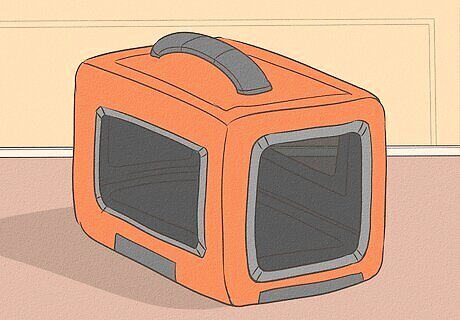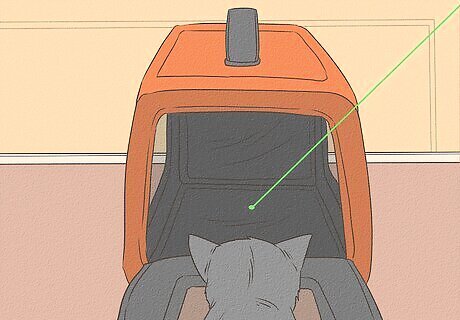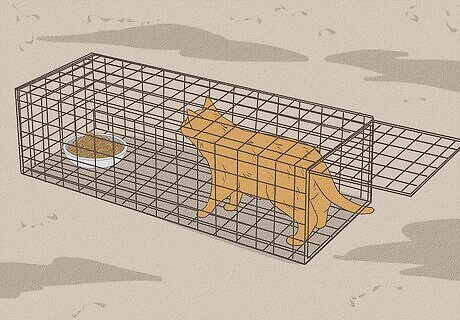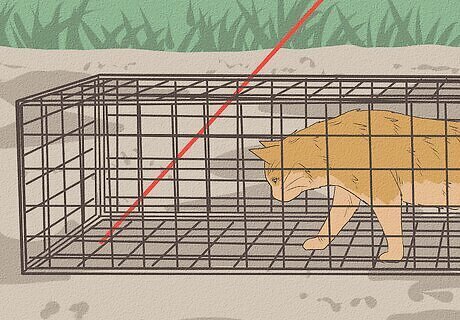
views
Catching Your Own Cat

Try a direct approach. You might be able to catch your cat simply by beckoning it or calling to it. If it comes near, try picking it up. However, never try to touch an animal that seems fearful or upset, since a scared cat can quickly become violent. If yours reacts negatively when you try to pick it up, leave it alone and try later. Signs that a cat is scared or upset include: Tail held straight up and stiff Ears folded back Paw raised, with or without exposed claws ”Striking” with its paw Low meowing or growling Hissing or spitting Hair raised on end Arched back

Wait for the cat to come to you. You might also be able to catch your cat when it least expects it. Avoid staring the cat in the eye or trying to reach for it when you first see it, since these gestures can be perceived as threatening. Instead, sit somewhere quietly and calmly, and wait for your cat to jump in your lap. Then, gently grab it.

Protect your skin. Handling a cat when it does not want to be picked up or is scared can lead to some scratching or biting. If you are trying to catch a cat in a hurry (such as one that has suddenly run outside) just grab any towel or blanket to wrap around the cat once you find it. This will help to calm the feline, and also protect you from harm. If you have time to put on gloves and long sleeves, these can also help protect you.

Grab the cat gently. Once you find your cat, grasp it firmly in your hands (but without squeezing it) and pick it up. If you have a blanket or towel, throw it over the cat to slow it down, then grab the cat within the blanket and clutch it securely to your chest. Grabbing a cat too forcefully or holding it awkwardly will make the situation much worse when you are trying to catch it. If at all possible, place one hand behind its front legs and your other hand under its hindquarters, lifting gently. Never pick your cat up by its neck or by its legs alone.
Getting Your Cat into a Carrier

Get a container to catch your cat in. A regular pet carrier (available at pet supply stores) is just fine. Look for one that is big enough for your cat to turn around in, but small enough to feel cozy. You can line the bottom of the carrier with a towel, blanket, or even an old t-shirt to make it more comfortable for your cat.

Prepare to trap your cat. If you are try to catch your cat indoors, corralling it into a room can make it easier to get it in its carrier. Make sure beforehand that all doors and windows are shut, and that there are no easy places for the cat to run to or hide in. If you are trying to catch a cat outdoors, you can try to get the cat into a mostly enclosed area first, and keep any exits blocked. For example, if there is a hole in a fence, cover it with a board first so that the cat cannot escape through it.

Encourage your cat to enter the carrier. Set the carrier near your cat, leaving its door open. See if the cat will enter the carrier on its own, or if you call its name first. Once the cat is fully inside, close the carrier door quickly but gently.

Gather bait. If the cat will not enter the carrier on its own, you may have to motivate it with food. Your cat’s favorite treats will do fine, or try a smelly, wet food such as tuna, sardines, canned cat food, and moist pieces of chicken. You can also try catnip or valerian, if your cat is attracted to these herbs.

Entice the cat with bait. Once you have the carrier and bait ready, try the following technique: Set the carrier near some treats with its door open. Wait for your cat to eat some. Place food nearer and nearer the carrier, if the cat will move closer to it. Place food inside the carrier and wait for the cat to step in and begin eating it. Once the cat is fully inside, close the door quickly but gently. Don’t try to force the cat into the carrier—it may run away, and you will have to start the whole process of catching it all over again. Once your cat is in its carrier, you can put a blanket or towel over it to help calm it.

Try other distractions if food does not entice the cat. A laser pointer or other toy can also be used to coax your cat into the carrier. Simply make the cat chase the laser pointer into the opened carrier, then quickly shut it.
Catching a Stray

Leave food out for the cat. Several days before attempting to catch a cat, leave a dish of food in the area where you have seen it. Dry food will work, but smelly, wet food such as tuna and canned cat food might be especially attractive to the cat. Keep replenishing the food supply, and the cat will be more trusting and likely to visit the area.

Use a humane trap to catch a feral or stray cat. Humane live traps, which will contain the cat without harming it, are available from animal supply stores and online retailers. You might also be able to borrow one from a local animal shelter. Look for a lightweight but sturdy one with two doors—a trap door and a release door. This will allow you to leave one door open to lure the cat in, and another to let it out safely. A live trap trap should include detailed instructions on how to set it and to release the animal. Make sure that you understand exactly how to work the trap before you attempt to use it to catch a cat. You can line the bottom of the trap with a towel or old t-shirt to make it more comfortable for the cat.

Gather bait. A cat will be drawn to food and enter the trap. Smelly, wet food such as tuna, sardines, canned cat food, and moist pieces of chicken will be most attractive to cats. Catnip and valerian are also irresistible to many cats.

Set your trap. Position your trap in the “set” position and place it in an area where you have seen the cat. Place your bait in the trap and wait nearby for the cat to appear. If you are trying to trap a cat in a public place, leave a sign on or near the trap so that others will know what is going on. Never leave a trap unattended for more than 20-30 minutes, in case another animal accidentally is trapped. If the cat is not trapped, try again another day with fresh bait.

Try to distract the cat into the trap if bait does not work. Get a laser pointer, and sit far enough away from the trap that the cat will not notice you. Wait for the cat to move near the trap, and try to make the cat chase the laser pointer into the trap.

Take the cat to a safe place. As soon as the cat is trapped, move it to an indoor location. Covering the trap with a blanket or towel can help calm the animal. Wearing gloves and long sleeves can help protect you from the cat’s claws.

Take the cat to the vet as soon as possible. Most animal advocacy groups recommend the policy of TNR (trap, neuter, and release) for feral and stray cats. This is considered a humane way of controlling stray cat populations. You can ask your vet or an animal shelter to spay or neuter your cat, and then release it back outdoors once it has recovered. You can even continue to feed the stray.




















Comments
0 comment